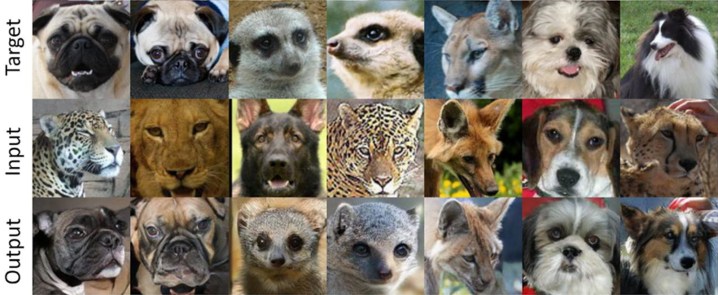
Can’t get your dog or that tiger at the zoo to smile for your Instagram? A new artificially intelligent program developed by researchers from Nvidia can take the expression from one animal and put it on the photo of another animal. Called GANimal — after generative adversarial networks, a type of A.I. — the software allows users to upload an image of one animal to re-create the pet’s expression and pose on another animal.
GAN programs are designed to convert one image to look like another, but are typically focused on more narrow tasks like turning horses to zebras. GANimal, however, applies several different changes to the image, adjusting the expression, the position of the animal’s head, and in many cases, even the background, from the inspiration image onto the source image. Unlike most GANs, the program is designed to work with any animal.
Just how well it works, however, is up for debate. One of the sample images shared by the researchers makes a pug look more like a mastiff and a fox look more like a lynx. While some of the sample images have a rather creepy look to them, the research could have important implications on future A.I. research.
As Nvidia explains, previous programs needed several images of the target animal to work, where the new program needs only one. The researchers call the variation a FUNIT — “a Few-shot UNsupervised Image-to-image Translation” algorithm. The target, or animal the new expression is to be added to, is specified with a small handful of images instead of the mass number usually required to train artificial intelligence programs.
The program learned to mix those expressions onto a new animal in the same way that a lot of people learn — practice. “In this case, we train a network to jointly solve many translation tasks where each task is about translating a random source animal to a random target animal by leveraging a few example images of the target animal,” said Ming-Yu Liu, one of the lead researchers on the project. “Through practicing solving different translation tasks, eventually the network learns to generalize to translate known animals to previously unseen animals.”
The work could lead to real-world uses with additional research, Nvidia suggests, including the creation of live-action movies using easily trainable dogs, then using A.I. to turn those dogs into tigers. But, the work is also an ongoing part of researcher Liu’s goal to use neural networks to give software an “imagination” that’s more human.
The program is available to try out on your own photos at Nvidia’s AI Playground.




